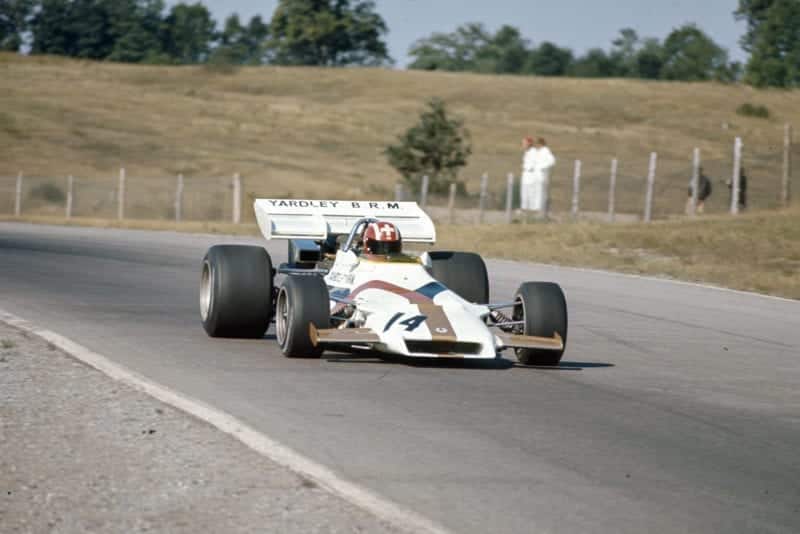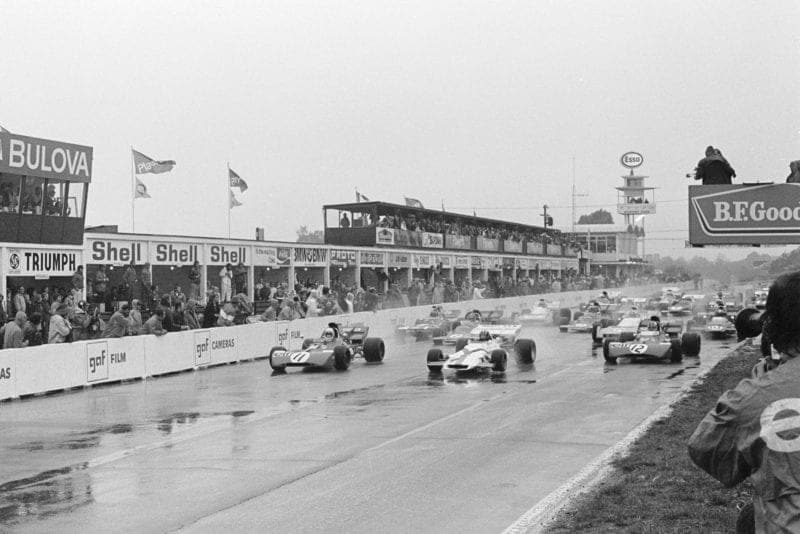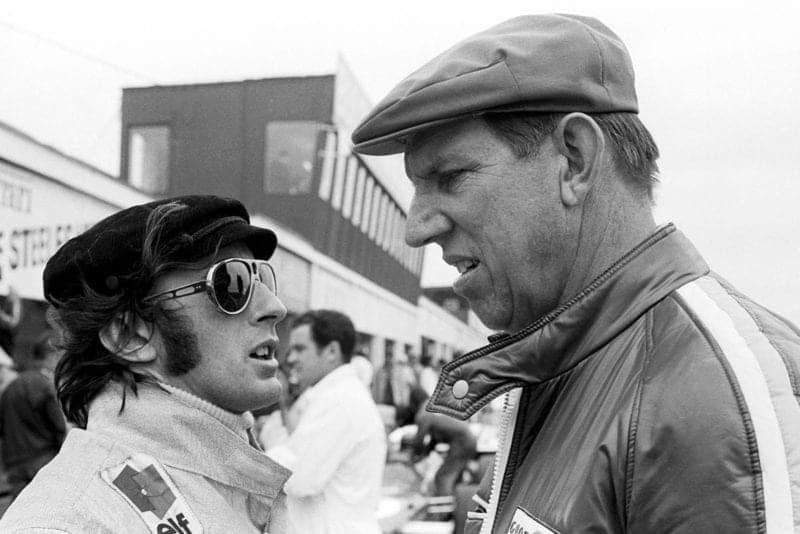1971 Canadian Grand Prix race report

Jackie Stewart won his sixth race of the season at Mosport Park in Canada
Motorsport Images
Stewart shows championship form in wet—Peterson strong challenger
Mosport Park, September 19th.
While there is no doubt that Jackie Stewart and the Elf Team Tyrrell have had a tremendous year the one black spot was the poor showing in the rain-soaked Dutch Grand Prix at Zandvoort. Those who like to knock Stewart dismissed him as a fair-weather driver, although the fact that none of the other Goodyear-shod drivers showed in the wet was perhaps an indication that something was wrong in the rubber-wear department. Since then the engineers at Wolverhampton have obviously done their sums again and on the streaming wet track at Mosport Park Stewart proved that he is every bit a World Champion in the wet or the dry. Yet again the young Swede, Peterson, proved that he is no respecter of experience or reputation and for a while overtook Stewart, although he later dropped back. Mark Donohue confirmed what had long been suspected—that he is probably America’s best driver of road-racing machinery and his first-ever Formula One drive produced a third place.
The Canadian Grand Prix is one of the most recent on the calendar and this year’s event was only the fifth in the series, which alternates between the Mosport track in Ontario and Le Circuit Mont Tremblant in Quebec. The Mosport track is just under 2½ miles long and is something akin to Oulton Park with its gradients and twists and turns—definitely a driver’s circuit. By American standards the amenities are not very good, but the organisation is friendly and efficient without being gushing.
There were 27 entries for the 24 places on the grid, although 22 had guaranteed starts and the other five had to fight for the remaining two places. As it happened, when the flag dropped anyone who could start did.
Fresh from their recent victories Yardley-Team BRM brought along cars for no fewer than five drivers, a massive undertaking and one that has not been attempted by any of the works teams in the current Formula One. Four of the cars were the latest P160 and these were allocated to their regular drivers, Siffert, Gethin and Ganley, while the car which is normally Siffert’s spare was to be driven by Toronto’s George Eaton, who raced for the team during 1970 and has hardly been heard of since. Completing the BRM line-up was Helmut Marko, having his third race for the team, but his first as a works rather than “rent-a-car” driver.
March Engineering also had five cars on the entry list but two of these were privately owned. Peterson headed the team with his regular car (an experimental flat-nose was available and tried only briefly), Galli was in his usual car, while Beuttler took over the third works car usually raced by de Adamich. To add to the confusion this car was run with one of the Ford engines from Beuttler’s Clarke-Mordaunt 711 rather than its usual Alfa power unit. A deal for Canadian John Cannon, who has been racing a March 712 in Europe, to drive the usual Beuttler car fell through. American Skip Barber had his Triple R Oil Filters March 711, as seen at Monaco and Zandvoort, using a completely unpainted monocoque tub, while the Frank Williams outfit had their modified March 711 on hand for Pescarolo.
The Tyrrell team brought along all three of their Tyrrells for Jackie Stewart and Francois Cevert, the older 001 being not only a serviceable but probably race-winning car in Stewart’s hands. All three were in standard short wheelbase form.
There was plenty of intrigue in the McLaren camp for the ex-Gethin car M19A/1 had been sold to Roger Penske Racing Enterprises for Donohue to drive but was still being run under the wing of the works who also had M19A/2 for Denny Hulme. The Penske car had been resprayed in the team’s smart blue colour scheme and, as is expected from Penske, was absolutely immaculate. As briefly seen in Austria on M19A/1, both cars now had completely conventional wishbone and link rear suspension, although the rising-rate front suspension had been retained. The results seemed to indicate that the rising-rate suspension was something of a blind alley and it is worth remembering that back in 1964 Tony Rudd designed a very similar system on the BRM but abandoned it before the end of the year.
Gold Leaf-Team Lotus were back at full strength with unchanged Lotus 72s for Fittipaldi and Wisell, and Matra were also back to two drivers bringing along unchanged Matra-Simcas for Chris Amon and Jean Pierre Beltoise, although only the former benefited from the bifurcated exhaust port-headed engine.
There were three Brabhams present, the unique BT34 for Hill, Schenken’s BT33 and the similar car which has now been sold to Ecurie Evergreen for Chris Craft to drive. This was Craft’s first World Championship race, although he had driven the car at the Gold Cup meeting. Since then it had been painted in the Evergreen colours and even bore the advertising for a local pickle company.
Despite the Monza debacle, Ferrari were at full strength with the usual three B2s for Ickx, Regazzoni and Andretti with the last of the B1s as raced by Ickx at Monza as a spare. Team Surtees brought just two TS9 cars, Surtees himself reverting to 004 and Stommelen returning to 002, which had been back in the jig at Edenbridge since its last race, and featured an altered rear bulkhead, plus the necessary attachments to convert it into side-radiator form if necessary. Finally the American, Pete Lovely, who has been cropping up at odd Formula One races for the past couple of years with a Lotus 49, came along with a new special he had built. Basically it featured a Lotus 69 Formula Two monocoque (the ex-Graham Hill car) with the rear section of the old Lotus 49 quite neatly grafted onto the back of it. A larger radiator and Chevron F2-type nose were incorporated in the design and the only major drawback seemed to be that the fuel tankage was insufficient for a full-length Grand Prix.
Qualifying

Jo Siffert qualified his BRM an impressive 2nd behind Stewart.
Motorsport Images
Practice was scheduled for a total of four sessions over Friday and Saturday totalling seven hours in all, which gave the considerable number of drivers who had not raced at Mosport adequate time to learn the track. Friday started off damp but the track quickly dried while there was beautiful sunny weather all Saturday which brought a lot of campers to the circuit. Two men dominated the practising— Stewart and Siffert. While Siffert probably had the advantage of more power from the BRM V12, Stewart’s Tyrrell and other Goodyear contractees were helped by a new tyre compound developed by the American engineers in Akron rather than by the Wolverhampton factory. The compound, G28, seemed to give a considerable improvement over the old tyre.
For the third session Stewart reverted to the older Tyrrell as his newer car was in gearbox trouble and at this point Siffert actually took pole position, but in the last two hours Stewart reduced his time to 1 min. 15.3 sec. while Siffert was unable to improve on his best at 1 min. 15.5 sec. This got the locals very excited for the Formula One lap record stood to Ickx and Brabham at 1 min. 18.1 sec., but that was two years ago and there have been considerable advances in tyres and chassis since then.
The only other driver to break the 1 min. 16.0 sec. mark was Francois Cevert, yet again showing that he is a fine shadow for Stewart. After Cevert came a great gaggle of drivers who all recorded times within the 1 min. 16.0 sec. to 1 min. 16.5 sec. bracket. They were Fittipaldi, Amon, Peterson, Wisell, Donohue, Ganley, Hulme, Beltoise and Ickx. Regazzoni was also in the same bracket but in the T car which he took over after wiping off the front end of the B2 during Friday afternoon’s session. However, the newer car was repaired for the race. Of this group Ganley’s effort was particularly noteworthy, as was Donohue’s—the thoughtful American progressively becoming quicker and quicker.
Of the five non-guaranteed entries the two BRMs both qualified without too much sweat, although team manager Tim Parnell kept Marko restricted to a limited number of laps, even though the eager Austrian would have liked more, and his spectacular style was reminiscent of Rindt in his earlier days. Pescarolo had a very unhappy weekend and had two engines blow up under him almost immediately he started to practise the Williams car. Finally a spare was borrowed and in the Sunday morning half-hour shakedown session he understeered off the road and through a fence which, though it did little damage to the car, cut and bruised his neck quite badly and he was unable to start after all.
For once the mechanics were able to watch some real motor racing rather than just see their cars flash by, for turn 10 is immediately before the pit straight and is a difficult, medium-fast bend. Being watched by their own pit through a corner like this seemed to spur all the drivers on to greater things. The bad tyre vibration which has been a problem this year was particularly noticeable at this corner and the chattering noise could be clearly heard on some of the cars.
Race

The race gets underway in treacherous conditions
Motorsport Images
Race day did not go smoothly at all for there were several preliminary races and in the last of these a Formula Ford driver hit the back of an ambulance attending another accident and was killed instantly. Due to Canadian law this held up the proceedings for two hours and by the time things were finally sorted out it was starting to rain quite heavily. The drivers were given five laps or so to acclimatise to the conditions and reports were coming from all round the circuit of spins galore. Right out of luck was Ganley, who steered into a guard rail avoiding Andretti, who was having a moment, while Hill also thumped the Armco but limped back to the pit where frantic activity by the mechanics had the car on the grid just in time. Ganley was out and his place was taken by Lovely as Craft’s engine developed an ominous noise as it was being warmed up.
So finally, two hours late, the flag dropped and the race was on with Stewart getting the advantage into the first turn while the rest just disappeared under a cloud of spray. Up at the tight turn 3 there was a bit of a mix-up, during which Siffert got so sprayed with mud that it completely obscured his vision and he disappeared into a ditch and out of it again with the car plastered with mud and way down the field. It was undoubtedly the blue Tyrrell out in front, but Peterson was holding second place with Beltoise a surprising third and Donohue fourth. Then came Fittipaldi, Cevert, Ickx, Wisell, Surtees, Amon, Andretti, Hulme, Regazzoni and the rest. Schenken failed to come round at all but the fault was in the electrical system. Finally mechanics got out to him, replaced the spark box, but by then it was too late to continue. In fact, the race was a disaster for the Brabham team for on lap 2 Graham Hill spun and damaged the oil tank so he limped back to the pits and retired.
Everyone was really tip-toeing round for the Mosport track seems to hold the oil and it was obviously extremely treacherous and lap times were 40 sec. off practice times. Stewart maintained his lead, while on lap 4 Beltoise slipped ahead of Peterson but only for three laps. Once back in second spot the Swede started to make up ground on Stewart spectacularly. Beltoise held third place ahead of Donohue, who had pulled away from a group comprising Ickx, Fittipaldi, Wisell and Cevert. Hulme had noticeably made up several places while Siffert had to stop to have the car’s nose section unblocked and restarted last. On lap 8 Regazzoni’s unhappy weekend came to an end when he lost it at turn three and thumped the barrier backwards. The electrics burst into flames, but the fire was quickly extinguished and Regazzoni, who crashes more than most, walked back for the second time in three days to explain to Forghieri.
Ferrari’s hopes were not really as high as expected for lckx certainly was not showing the Zandvoort wet-weather form and Andretti had made a pit stop with a misfiring engine and then soldiered on with oil spraying from the engine onto the back brakes which made everything very difficult.
Stewart and Peterson were quickly working their way through the back markers, as was Beltoise, but he came up against a rather stubborn one and, in his attempts to pass, he lost it on lap 15 at turn 10 and the resulting impact damaged the front suspension beyond repair. Mark Donohue had made a quick stop for a clean pair of goggles (he was one of the few not wearing a Bell Star) but still held fourth place so now he moved up to third.

Ronnie Peterson and Stewart fight it out for the lead
Motorsport Images
At this stage Peterson was really giving Stewart a hard time, although, while the Scot was driving in his usual precise manner, the Swede was having several adventures. Both were choosing very special non-dry weather racing lines through the corners in an attempt to gain more traction. But after briefly passing Stewart a couple of laps earlier Peterson got in front and stayed that way on lap 18.
At least the rain-soaked spectators had something to make their visit worthwhile and this dice between the established champion and the new up-and-coming challenger was definitely it. The gap varied considerably but it was never more than about 3 sec. as Stewart waited for Peterson to make a mistake. But the March driver had fettled down and was hardly putting a foot wrong so Stewart had to exert his tremendous skill and he finally managed to regain the lead fair and square on lap 31.
By this stage only Donohue remained unlapped in third place, lckx was fourth but Denny Hulme, not noted as a great wet weather driver, had clawed his way right up the field to fifth position ahead of the two Lotus 72s with Wisell now challenging team-leader Fittipaldi, Cevert was back in eighth place in the second Tyrrell, Siffert had moved up well but was finding it very difficult to pass Surtees for ninth position.
Hopes that Peterson may again challenge Stewart took a tumble on lap 32 when the pair came up to lap George Eaton down in 16th place. He saw Stewart and let him through and immediately moved over on Peterson who was following closely. The March’s front wing was knocked at an angle and he lost a lot of time in the incident and from then on started to drop back as he wrestled with the strange handling afforded by the cock-eyed nose. For a few laps Donohue started to gain on Peterson but then he dropped back as Peterson speeded up. By lap 35 Hulme had moved up into fourth place. Wisell had passed Fittipaldi and looked like overtaking Ickx as well. Barber had long since dropped out when his engine lost all its oil pressure, while Stommelen had a moment and knocked off a water pipe and by the time he noticed the water temperature was off the clock it was too late and he retired with an overheating engine. However this still left 18 cars circulating in the slightly drying conditions with all eyes still focussed on the progress of Peterson although it looked as if Stewart had the race in the bag while his team mate Cevert was obviously making a late bid to improve his position.
During the third quarter of the race the rain had ceased and the track was drying slightly but a heavy mist was starting to fall and visibility was definitely getting worse. By lap 60 the marshals were reporting to race control that they could not see from one post to another. The officials consulted their rule books and realised there was provision for stopping the race without affecting the results or the World Championship as over 60% of the distance had been completed. So as Stewart completed the 64th lap, after almost two hours’ racing, he had the chequered flag waved vigorously at him and he had won his sixth Grand Prix of the year. Ronnie Peterson came home to his fourth second place of the year (the third behind Stewart) some 38.3 sec. in arrears while Donohue, still unlapped, was in an excellent third place.

Stewart (left) took his sixth win of the season, no doubt pleasing team boss Ken Tyrrell (right)
Motorsport Images
Hulme’s tenacious drive earned him fourth place and the fastest lap, Wisell was fifth, while in the closing stages Cevert had moved ahead of both Fittipaldi and Ickx, who finished up in eighth place. Siffert came home ninth, although undoubtedly he would have been better placed had it not been for that first lap incident, while Amon was an unhappy 10th ahead of Surtees, Marko, Andretti and the rest.—A. R. M.
